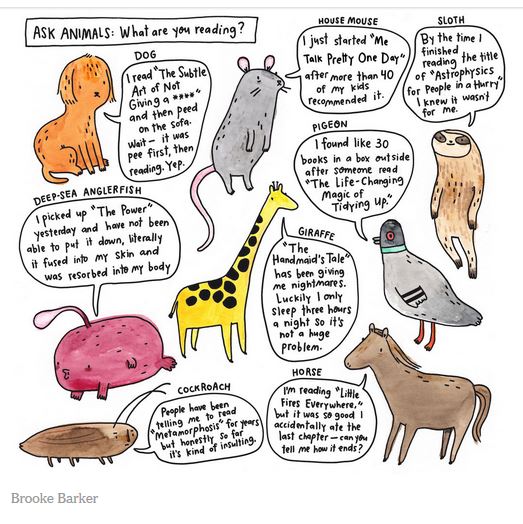Blogging & Musing
 There are so many—they're the unsung heroes—WOMEN who made astonishing contributions to science and to the Allied war efforts.
There are so many—they're the unsung heroes—WOMEN who made astonishing contributions to science and to the Allied war efforts.
For half a century or longer, their lights were hidden under bushels—but not by their own doing.
Their accomplishments went unrecognized, were dismissed, in some cases, ridiculed … and for one reason: they were FEMALE.
Thankfully, today, many are finally getting the recognition they deserved yet were so long denied. Their achievements have been heralded through a profusion of recent books. It's time.
Let's start in 2016 with Hidden Figures, Margot Lee Shetterly's book about the black female mathematicians at NASA during the early rocket age: they struggled in the face of both sexism AND racism—a doubly high barrier.
Though Hidden Figures is hardly the first book about unrecognized women, it's perhaps the most famous. In addition to reaching bestseller status, the book also became a BLOCKBUSTER FILM—earning close to a quarter of a BILLION world-wide.
This January Marie Benedict published The Only Woman in the Room, a novelistic treatment of the famous Hollywood film star, Hedy Lamarr. Lamarr led a double life: she was also a crack scientist who invented a radio-guided torpedo system.
Although dismissed by the military during World War II, Lamarr's invention later played a role in developing GPS and cell phones. Hedy's Folly, a nonfiction work on the same subject, was published by Richard Rhodes in 2011.
Also out this January is Larry Loftis' nonfiction account of Odette Samson, a female British spy dropped into Nazi territory—Code Name: Lise.
AND get this! Pam Jenoff has just released a FICTIONAL treatment of real life female British spies … dropped into Nazi territory—The Lost Girls of Paris.
THIS just in, a late entry: April 9, 2019, saw the release of Sonia Purnell's A Woman of No Importance: The Untold Story of the American Spy Who Helped Win World War II.
2017 saw a number of books about female breakthroughs in male domains. CODE-BREAKING proved a big topic that year: strangely, TWO nonfiction works were both devoted to one woman in particular—Elizebeth Smith Friedman.
Elizebeth, a groundbreaking cryptologist, founded along with her husband the modern science of cryptology prior to and during WWII. After the war William Friedman went on to head up NSA's cryptology unit—and even had a building named in his honor. It took decades for Elizebeth's name to be added to the plaque—even though some considered her the BETTER coder.
Check out these two nonfiction works on Elizebeth Smith Friedman:
• The Woman Who Smashed Codes by Jason Fagone
• A Life in Code by G. Stuart Smith
In the VERY same year (we're still in 2017), came Code Girls by Liza Mundy. Again, during the war years, the Army and Navy recruited women from around the country to learn code-breaking. They moved to Washington to take up the challenge, and only now, after years of secrecy, are we learning of their impressive contribution.
Also, in 2017, Jennifer Chiaverini came out with The Enchantress of Numbers, a fictional telling of Ada Lovelace, daughter of poet Lord Byron. More than a century passed before Lovelace was acknowledged as the developer of computer language (i.e., code). That's right, she was essentially the FIRST computer programmer—and it was the 19th century!
Finally, in 2017, moving away from math and science, Chuck O'Brien released Fly Girls, a nonfiction account of female aviators during the 1920s and '30s. The women, talented flyers in their own right, had to fight in order to compete against men in popular air races. In the face of ridicule, they managed to beat their male counterparts … a lot.
This is hardly an exhaustive list, but I'll stop here. There are many more books championing unsung female achievements; these are just the ones that came to mind.
So wouldn't it be a great idea to spend an ENTIRE BOOK CLUB YEAR reading about these remarkable women … and the many others I've left out?
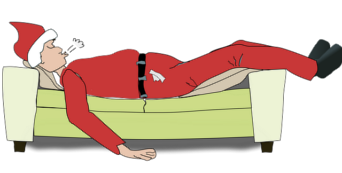 Favorite week of the year—the week AFTER Christmas. It's time to collapse … because we can. Finally.
Favorite week of the year—the week AFTER Christmas. It's time to collapse … because we can. Finally.
I wonder how many feel the same kind of dread I do as we move into November: knowing that Christmas is getting closer… closer… closer…
And that means gift shopping, food shopping, cooking, baking, wrapping, cleaning up, washing up (bowl after pot after pan), making up guest beds, trudging up to the attic or digging through closets to drag out boxes of decorations, decorating, setting the table, more cooking, more baking, more cleaning, and more washing up.
And all this is ON TOP OF the regular tasks of our day-to-day lives—which, let's face it, are already plenty busy.
None ot this is to denigrate the deep joy the season brings, spiritually and communally—the candle-light services, the gorgeous music, and the connection with family and friends.
But when it's over—the gifts opened, the dishes done, the visitors come & gone—it's time to LIE BACK on a couch, put up those weary feet, pick up a BOOK AND READ.
So Merry (WEEK AFTER) Christmas, everyone—it's the best time of the year!
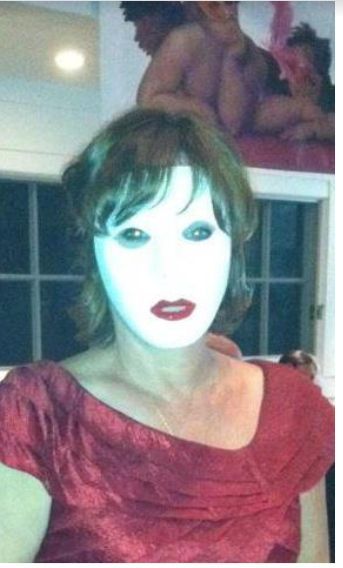 By guest blogger, Kathy Aspden, author of Baklava, Biscotti, and an Irishman. Kathy is in the process of wrapping up her second novel.
By guest blogger, Kathy Aspden, author of Baklava, Biscotti, and an Irishman. Kathy is in the process of wrapping up her second novel.
Early in my writing career, one of my favorite mentors dropped this pearl of wisdom: Flawed characters are more loveable.
I’m sure most writers (along with most people) already knew this. I didn’t. I was always trying to give my protagonist superhuman qualities, such as perfect motives or having a righteous cause on his or her side. The concept of a person selfishly wanting their own way simply because it’s what they wanted seemed almost evil.
What a boat I was missing! This one gift of advice changed my life completely. It was a revelation. We don’t love people because they are perfect; we love them because we love them.
It opened a whole new world to me, both in my writing and in my life. I suddenly couldn’t wait to create the next flawed character; the trick being to infuse complicated, negative traits that also generated love, sympathy, and relatable feelings. My kind of puzzle.
I began writing about characters who did horrible things and were still worthy of love. I watched them suffer the anguish of their sins, further ruining their lives when they couldn’t make peace with themselves. I fabricated players willing to overlook the craziest of transgressions for the sake of love; or to reconcile their own unforgivable pasts. I wrote my way into the epiphany that the early life of a parent, even when well hidden, factors into the future misery of a child.
With every story I learned more about myself. I had been living a half-life, trying to hide, dismiss or spin my shortcomings into the image of perfection. It was exhausting—and unnecessary.
I realized even my opinions hadn’t been bendable. If I stated a belief or truism, fourteen years ago, it was written in indelible ink—leaving me no emotional ability to say, “I’ve changed my mind!” I was being held hostage by my own beliefs to opinions and ideas that no longer served me.
My life was a two-dimensional picture and I had no idea how to get to the depth of it without taking something back—saying I was wrong, admitting I was imperfect.
Five screenplays, two novels, countless blogs and short stories later, I’m happy to say that perfect ship has sailed. Writing about the lives of others has put my own life into perspective. I have a more genuine relationship with my children—who know beyond a shadow of a doubt I’m not perfect. My mother and I have never been closer. I laugh with my husband about the mistakes we’ve made (relationship, child rearing, financial), experiencing little to no shame. And I have to admit my siblings are relieved to have witnessed my swan-dive off the pedestal of perfection. In truth it was more of a belly flop. I’ve never been happier.
Am I a mess? For sure. Does being a mess help my writing? You bet! It’s a two-way street. My characters are now as fond of meas I am of them. We share a newfound love of deeply flawed people and we wouldn’t have it any other way.
 By Molly Lundquist, LitLovers
By Molly Lundquist, LitLovers
Don't know where YOU live, but where I live we haven't seen sun since, well… since October 30th. A dark, heavy curtain dropped on us. BOOM—no second act.
Occasionally, we get a glimpse of a bright orb (or something) but never for long and NEVER two days in a row. Some speculate it might be the sun. but no one's really sure.
If it sounds dreary, it is.
Ah, but there are lovely compensations. Cold, cloudy weather—plus the end of Day Light Savings—is all the excuse any of us need to hole up in our caves for a GOOD READ.
CLOUDY WEATHER READS
A Few Favorites
• The Dream Daughter - Diane Chamberlain
(See our LitLovers Book Review.)
• How to Change Your Mind: The Science of Psychedelics - Michael Pollan (See our LitLovers Book Review by P.J. Adler.)
• The Mermaid and Mrs. Hancock - Imogene Hermes Gowar
(See our LitLovers Book Review.)
• Varina - Charles Frazier
(See our LitLovers Book Review.)
• The Winter Soldier - Daniel Mason
I live in Pittsburgh, by the way. But I've noticed that a lot of the country from the Midwest to the East Coast hasn't had terrific weather either lately, so I figure lots of us have turned to BOOKS—a heartening thought.
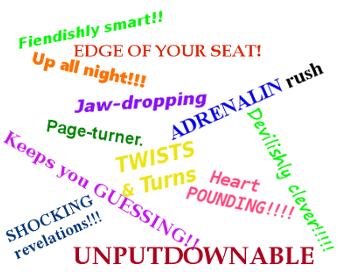 Recognize any of the phrases to the left?
Recognize any of the phrases to the left?
Hard not to. They're taken verbatim from reviews of suspense novels and are repeated over and over in cover blurbs and ads (because, really, how many ways can you say "exciting"?).
Add to that…nearly every thriller gets hailed as "THE NEW GONE GIRL OR THE GIRL ON THE TRAIN!!!!!"
My problem is I've grown tired of heart-thumpers (a phrase not on the list, btw)—of being on the edge of my seat for 384 pages—and reading in PANIC MODE.
So Dear Reader, confession: I skip ahead … to the last couple of pages. I need to see if my favorites make it through intact so that I can just settle back and enjoy the ride. After all, isn't that the point of reading—to savor the words, their rhythms and nuances and to luxuriate in wherever a story happens to take us?
Listen, I LOVE a good thriller—every now and then. But it should come as no surprise that, since Gone Girl, thrillers have been flooding the market. It seems as if the publishing industry has gone mad with its outpouring of beautiful psychopaths.
Worse, even writers of "literary fiction" are adding touches of thrillerdom to jazz up their plots and, I guess, juice up their sales. Oh, well. 'Nuf said.
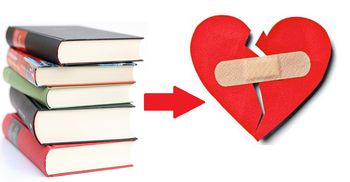 Dear Reader. Maybe it's about time for this post. Like you, I bet, I've been distressed — no, horrified — by the divisiveness and ugliness pervading our public discourse.
Dear Reader. Maybe it's about time for this post. Like you, I bet, I've been distressed — no, horrified — by the divisiveness and ugliness pervading our public discourse.
We've turned against one another: liberals and conservatives, globalists and populists, blacks and whites, men and women, religious and nonreligious, elites and … well, pretty much everyone else.
But here's the good news. We have BOOKS. Novels, especially, are sources of refuge — with the power to heal, to bind wounds and the wounded.
Through book clubs—with our books—we come together to share the love of story. We visit different cultures and are exposed to different ideas. We grow our empathy. We locate ourselves, for a time, in a wider world. We understand — because we are well read — that change is inevitable. But we also understand that there are lasting values which must be protected, always.
Those "lasting values," though, can get us into trouble; how we define them differs, which makes them easy to politicize. You could say the idea of values is what divides us.
But there ARE lasting values, ones we can all agree on. First and foremost is KINDNESS, and we can find it in literature. Many of our favorite books are those in which kindness is found in unexpected places, in which an open, generous spirit prevails over cruelty and selfishness, anger and fear.
A second is belief in the DIGNITY of every individual. That's a hard one. It's much easier to play the lowest card in the deck and resort to name-calling — I know, I've done it. Yes, shamefully, I've indulged in vitriol.
Yet literature is rife with the acknowledgement of human worth — that individuals, no matter how vile or how degraded, possess an inner core of dignity.
Moral to this blog post: Make the world a better place—READ A BOOK. End of sermon.
 By Kathy Aspden, Author *
By Kathy Aspden, Author *
Here’s the thing I love about screenwriting – it’s about using the fewest words to create the largest picture.
There’s a wonderful economy in the language of films. You’re given two hours at best – which translates into 120 pages of script, one page per minute.
I’ve had table readings of my scripts – no action included – and have been surprised to find that it really is one minute per page.
So here’s your mission: Write a scene that doesn’t include the character’s thoughts, desires and complex histories, but somehow conveys a character’s thoughts, desires and complex histories. It’s like a puzzle.
Add to that the fact that somebody important who’s reading your script does not want you to direct them. It sounds confusing, doesn’t it? It is.
RENNIE
I was wrong. You can tear up my contract and keep the money. I’ll take my chances on the outside.
This is a line from my screenplay, A PERFECT WORLD – a dystopic society in 2046 where America is bankrupt from taking care of the sick.
All illness has been traced to HPAS - Hybrid Procreation Autoimmune Syndrome – caused by the cross-pollination of people breeding outside their race of origin: The American Melting Pot. The government has decided it’s time to fix the problem before humanity is too sick to survive.
What if medicine suddenly became illegal and the sick were encouraged to die while America cultivated a new race?
Now picture my dilemma as the screenwriter. Exclamation points are frowned upon. Italics aren’t allowed. Underlined words are not encouraged unless absolutely necessary. Using all caps (ala Christian Gray style) is a complete no-no.
And yet my character, Rennie, is a woman in a government run clinic, who is thirteen-weeks pregnant with a genetically viable child, produced through a government sanctioned union, and she wants out.
She wants out at the top of her lungs. She wants out in spite of the fact that she has signed a contract. She wants out even though she knows that medical care outside of the facility has been deemed illegal.
SHE WANTS OUT!!
But it’s not my call as a writer to do the director’s job (or so they say). So I write the words and hope he/she gets it. Or more likely, I hope the twelve-year-old he/she intern assistant to the producer gets it.
It’s all good, though, as long as YOU get it.
* Kathy Aspden is the author of Baklava, Biscotti, and an Irishman, as well as a book reviewer for LitLovers.
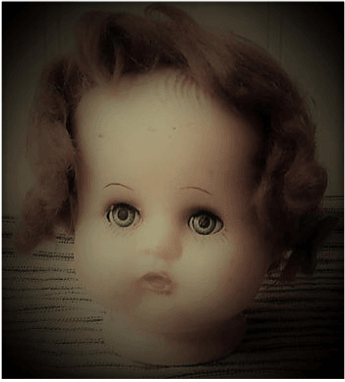
Writing is a lot like making a baby. Sometimes, it takes everything to get to the point of conception, and sometimes you don’t even remember having sex that night, but somehow a baby was conceived. Either way it all begins with a tiny seed that is planted in your heart (or your brain if that’s how you’re wired).
Even before conception, the image of your child is already materializing: "He’ll have my eyes, my husband’s lips, and hopefully not Uncle John’s nose…" In anticipation, a parent is creating a composite baby in their mind. It’s the same for writers. We envision different blends of traits, strengths and weaknesses for our characters.
"Composite Character" is a term I was certain I had invented, right up until I looked it up on Wikipedia. What I found was that I had been intuitively using a process that many writers and filmmakers have done forever - take two or more people from real life or experiences or even history, and meld them into one quirky, interesting person with the capability of being both deeply flawed (as most great characters are) and relatable. It was another case of my inventing something that somebody else had already invented (insert travel hammock, swinging screen door for sliders, the instant ballerina-bun maker).
The strange thing is that I can’t tell if my characters begin to remind me of someone who then creeps into my head as I write, or if there is already a person in my head whose traits have crept into my character. Anyone who knows me may have guessed that there’s probably more people in my head than is considered healthy. Whatever the reason, my characters tend to take on a lot of personality traits – like snowballs down a mountainside — as their stories progress.
I'm more aware of it when I'm writing screenplays. It's easier to have an actor to visualize as the script unfolds. And why wouldn’t an actress like Julianna Moore (with a little Diane Keaton thrown in) want to play the part of Grace Mitchell, a forty-nine-year-old author who has just written a successful self-help book decrying America’s obsession with youth, but stands to lose everything when she finds herself pregnant by a thirty-eight-year-old plastic surgeon? Great plot, right? (An Inconvenient Miracle is available for option if you happen to be a successful movie producer).
Anyway, back to these mixed-up characters of mine. What I came to realize was that my psychiatrist had been wrong; the voices in my head were a good thing. Working with the public, being part of a large family, inheriting a natural love of human interaction from both my mother and my father gave me a lifetime’s worth of crazy, loveable parts and pieces to choose from when writing. This mental/multi-tasking/ADD portion of my brain was finally paying off! On top of that, I found a great app that allowed me to see my combos by physically blending people.
Here’s my JulianneDianeKeatonMoore blend.
P.S. I also invented the first Transformer, the epitome of the composite character — a doll head that turned into a change purse. I didn’t call it a Transformer. I called it a Doll-head Purse.
* Kathy Aspden is the author of Baklava, Biscotti, and an Irishman, as well as a book reviewer for LitLovers.
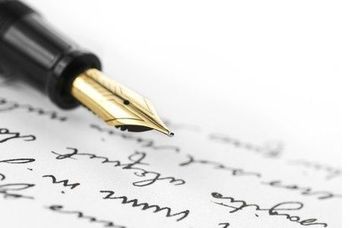 Cursive Cramp
Cursive Cramp
By Kathy Aspeden, Author*
A few years ago I took a creative writing class from Professor Patricia McGraw. It was a three-credit course designed for advanced writers.
Absolutely, I wanted to get the most out of the class.
But I also wanted to get an "A" (grade-seeker — a horrible trait leftover from not having achieved anything athletic in my childhood years). That meant doing all the homework, even the things I found redundant or repetitive. Everything.
Professor McGraw was a huge fan of cursive. She said it got our creative juices flowing to engage our hands in what is quickly becoming a medieval practice. Four handwritten lined-notebook pages a night. Ugh!
It was agony for me. I have terrible, scratchy handwriting. My hands do not form circles. I can’t get anything on my body to make a circle. Ankle rolls during yoga, hula hoop hips, all of it is difficult.
I’m not graceful, I’m purposeful. I can hand-draw a window opening without a level. I’m the chick that does all the cut-in for family painting project.
I don’t create circles or graceful arcs. Cursive is filled with pretty swirls of circles!
Can you imagine getting a mediocre grade because of a simple thing like cursive? It felt positively elementary-schoolish — until I got the hang of it. Yes, like most people my brain works faster than my hands. I had to relax my thoughts, which turned out to allow more time for different, additional thoughts. Who knew?
When I realized that Professor McGraw wasn’t looking at the content, I still felt an obligation to do the task justice. One day I wrote four entire pages of potential book titles that all flowed into one another. "The Life We Made – Making The Pie – A Pie in Your Eye – The Eyes Have It – It Happened in the Park – Park Plaza Promise - Promise You’re Not a Psycho – Psycho is Another Name for Different – A Different Desire…"
Once I wrote a grocery list from when I was a kid, "Chef-Boy-Ardee Raviolis, Captain Crunch Cereal, Frosted Pop Tarts, Tang – the choice of astronauts…" You get the picture.
Before class we’d compare notes about how ridiculous our journals were. One guy wrote everything the NHL Hockey commentator said. Another recorded all the commercials while she power-watched back-to-back episodes of Grey’s Anatomy. Still another student detailed every move her cat made — adding extremely funny dialogue in between actions.
We thought we were beating the system, but we had to admit that something was happening. Ideas were being triggered by the action of writing by hand.
Today, cursive is making a comeback.
I recently saw a news show about the Campaign for Cursive’s 2017 contest winners. It was filled with kids who were treating the learning of cursive like a language or an archeological dig. They were cursive powerhouses, proud to have mastered a language that many of their friends didn’t know existed.
I’ll leave you with a great link to Johanna Silver’s 9 Incredible Ways Writing by Hand Benefits Our Bodies and Brains, as well as a look back at all the hoopla New York Yankees star, Alex Rodriquez, generated with his handwritten apology to the fans of baseball.
Kathy Aspden, is the author of Baklava, Biscotti, and an Irishman, as well as a book reviewer for LitLovers.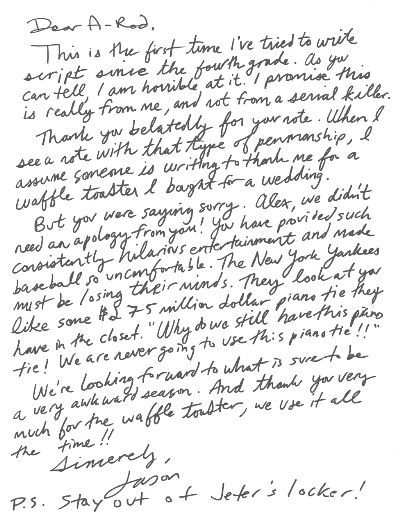
Site by BOOM
![]()
LitLovers © 2024


